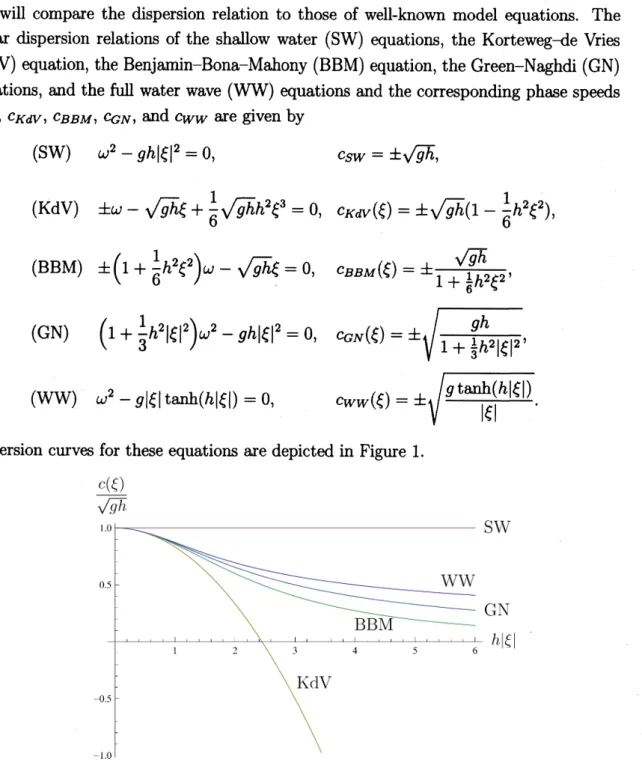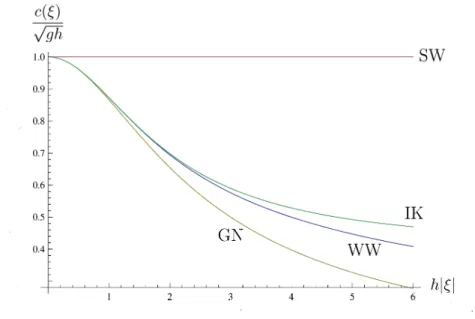Solvability of the
initial
value problem
to
a
model system
for
water
waves
慶慮義塾大学理工学部数理科学科 井口達雄(Tatsuo Iguchi)
Department ofMathematics, Faculty of
Science
and Technology,Keio University
1
Introduction
Thewater
wave
problemismathematicallyformulatedas
a
free boundary$p_{1}\cdot$oblem foran
irrotational flow of
an
inviscid and incompressiblefluid under thegravitational field. Thebasic equations for water
waves are
complicated due to the nonlinearity of the equationstogether with the presence of
an
unknown free surface. Therefore, untilnow
manyap-proximateequationshavebeen proposed and analyzed to understand natul.al phenomena
for water
waves.
Famous examples of such approximate equationsare
the shallowwa-ter equations, the Green-Naghdi equations, Boussinesq type equations, the Korteweg-de
Vriesequation, theKadomtsev Petviashviliequation, the Benjamin Bona-Mahony
equa-tion, the Camassa-Holm equation, the Benjamin-Ono equations, and so
on.
All of themare
derived from the waterwave
problem under the shallowness assumptionof the waterwaves, which
means
that themean
depth of the water is sufficiently small compared tothe typical wavelength ofthe water surface.
On the other hand, in coastal engineering
some
model equationswerederived withoutusing any shallowness aesumI)tion of the water
waves.
It is well-known that the waterwave
problem has a variational structure. In fact, J. C. Luke [7] gavea
Lagrangian intermsofthe velocitypotential $\Phi$and thesurfacevariation
$\eta$
.
His Lagrangianhastheform(1.1) $\mathscr{L}(\Phi, \eta)=\int_{b(x\rangle}^{h+\eta(x,t)}(\Phi_{t}(x, z,t)+\frac{1}{2}|\nabla_{x,z}\Phi(x, z,t\rangle|^{2}+g(z-h))dz$
and the action function is
$\mathscr{J}(\Phi,\eta)=\int_{t_{0}}^{t}/\Omega^{\mathscr{L}(\Phi,\eta)dxdt}$
’
where $g$ is the gravitational constant, $h$ is the
mean
depth of the water, $b$represents thebottom topography, and $\Omega$
is
an
appropriate region in $R^{n}$.
In view ofBernoulli’s law $($1.2$)$ $\Phi_{i}+\frac{1}{2}|\nabla_{x,z}\Phi|^{2}+\frac{1}{p}(p-Po)$ 牽$g(z-h)\equiv 0,$we
see
that Luke’s
Lagrangian is essentiallythe
integralof
the pressure$p$ in thevertical
direction of the water region. J. C. Luke showed that the corresponding Euler-Lagrange
equationis exactly the basicequations for water
waves.
M. Isobe [2, 3] and T. Kakinuma[4, 5, 6] used this variational structure of the water
waves
to derive approximate modelequations. They approximated the velocity potential in $Luke^{\rangle}s$ Lagrangian
as
$\Phi(x, z, t)\simeq\sum_{k=0}^{K}\Psi_{k}(z;b)\phi^{k}(x, t)$,
where $\{\Psi_{k}\}$is
an
appropriatefunction system, and derivedan
approximateLagrangianfor$(\eta, \phi^{0}, \phi^{1}, \ldots, \phi^{K})$
.
Their model equationsare
the corresponding Euler Lagrangeequa-tions.
There
are
several choices of thefunction system $\{\Psi_{k}\}$.
Aswas
shown byJ. Boussinesq[1], in the
case
of the flat bottom the velocity potential $\Phi$can
be expanded ina
Taylorseries with respect to the vertical spatial variable
as
$\Phi(x_{\sim}^{\gamma}, t)=\sum_{k=0}^{\infty}\frac{z^{2k}}{(2k)!}(-\Delta)^{k}\phi_{0}(x, t)$,
where $\phi_{0}$ is the trace of the velocity potential $\Phi$ on the bottom. Therefore,
one
of thechoice of the approximation
was
given by(1.3) $\Phi(x, z, t)\simeq\sum_{k=0}^{K}(z-b(x))^{2k}\phi^{k}(x, t)$
.
In the
case
$K=0$, that is, if weuse
the approximation $\Phi(x, z, t)\simeq\phi^{0}(x, t)$ in $Luke^{\rangle}s$Lagrangian, then the Lagrangian (1.1) is approximated by
$\mathscr{L}(\phi^{0}, \eta)=\int_{b(x)}^{h+\eta(x,t)}(\phi_{t}^{0}+\frac{1}{2}|\nabla\phi^{0}|^{2}+g(z-h))dz$
$=( \phi_{t}^{\mathfrak{o}}+\frac{1}{2}|\nabla\phi^{0}|^{2})(h+\eta-b)+\frac{1}{2}9(\eta^{2}-(b-h)^{2})$
.
The corresponding Euler-Lagrangeequations
are
exactly the shallow water equations.$\{\begin{array}{l}\eta_{t}+\nabla\cdot((h+\eta-b)\nabla\phi)=0,\phi_{t}+\frac{1}{2}|\nabla\phi|^{2}+g\eta=0.\end{array}$
In the
case
$K=1$, that is, ifweuse
the approximationin Luke’s Lagrangian, thenthe Lagrangian (1.1) is approximated by
$\mathscr{L}(\phi^{0}, \phi^{1}, \eta)=H\phi_{t}^{0}+\frac{1}{3}H^{3}\phi_{t}^{1}$
$+ \frac{1}{2}H|\nabla\phi^{0}|^{2}+\frac{1}{10}H^{5}|\nabla\phi^{1}|^{2}+\frac{2}{3}H^{3}(1+|\nabla b|^{2})(\phi^{1})^{2}$
$+ \frac{1}{3}H^{3}\nabla\phi^{\mathfrak{o}}\cdot\nabla\phi^{1}-H^{2}\phi^{1}\nabla b\cdot\nabla\phi^{0}-\frac{1}{2}H^{4}\phi^{1}\nabla b\cdot\nabla\phi^{1}$
$+ \frac{1}{2}g(\eta^{2}-(b-h\rangle^{2})$,
where $H=H(x, t)=h+\eta(x, t)-b(x)$ is the depth at the point $x$ at time $t$
.
Thecorresponding Euler-Lagrange equations have the form
(1.5) $\{\begin{array}{l}\eta_{t}+\nabla\cdot(H\nabla\phi^{0}+\frac{1}{3}H^{3}\nabla\phi^{1}-H^{2}\phi^{1}\nabla b)=0,H^{2} 恥 +\nabla\cdot(\frac{1}{3}H^{3}\nabla\phi^{0}+\frac{1}{8}H^{s}\nabla\phi^{1}-\frac{1}{2}H^{4}\phi^{1}\nabla b)+H^{2}\nabla b\cdot\nabla\phi^{0}+\frac{1}{2}H^{4}\nabla b\cdot\nabla\phi^{1}-\frac{4}{3}H^{3}(1+|\nabla b|^{2})\phi^{1}=0,\phi_{t}^{0}+H^{2}\phi_{t}^{1}+g\eta+\frac{1}{2}|\nabla\phi^{0}|^{2}+\frac{1}{2}H^{4}|\nabla\phi^{1}|^{2}+H^{2}\nabla\phi^{0}\cdot\nabla\phi^{1}-2H\phi^{1}\nabla b\cdot\nabla\phi^{0}-2H^{3}\phi^{1}\nabla b\cdot\nabla\phi^{1}+2H^{2}(1+|\nabla b|^{2})(\phi^{1})^{2}= O.\end{array}$
This isone ofthemodelproposed by M. Isobe and T. Kakinuma. In thiscommunication,
we
reportthe solvability oftheinitialvalue problemforthis Isobe-Kakinumamodal under the initial conditions(1.6) $(\eta, \phi^{0}, \phi^{1})=(\eta_{0}, \phi_{0}^{0}, \phi_{0}^{1})$ at $t=0.$
2
Basic
properties
of
the
model
The linearized equations ofthe $Isobe\frac{-}{}$Kakinumamodel (1.5) around the trivial flow
are
$\{\begin{array}{l}\eta_{t}+h\Delta\phi^{0}+\frac{}{}\Delta\phi^{1}=0\eta_{t}+\frac{h}{3}\triangle\phi^{0}+\frac{h^{3}h^{3}3}{5}\Delta\phi^{1}-\frac{4}{3}h\phi^{1}=0,\phi_{t}^{0}+h^{2}\phi_{t}^{1}+g\eta=0.\end{array}$
This system has
a
non-trivial solution of the form $\eta(x, t)=\eta_{0}e^{i(\xi\cdot x-\omega t)}$ if and only if thewave
vector$\xi\in R^{n}$ and the angular frequency $(Jj\in C$ satisfy the relationThis is the linear dispersion relation for the Isobe-Kakinuma model (1.5),
so
that thephase speed $c_{IK}= \frac{\omega}{|\zeta|}$ is givenby
$c_{IK}(\xi)=\pm\sqrt{gh\frac{1+\frac{1}{15}h^{2}|\xi|^{2}}{1+\frac{2}{5}h^{2}|\xi|^{2}}}.$
We will compare the dispersion relation to those of well-known model equations. The
linear dispersion relations of the shallow water (SW) equations, the Korteweg-de Vries
$(KdV)$ equation,
the
BenjaminBona
Mahony (BBM) equation, the Green-Naghdi (GN)equations, and the full water
wave
(WW) equations and the corresponding phase speeds$c_{SW},$ $c_{KdV},$ $c_{BBM},$ $c_{GN}$, and $c_{WW}$
are
given by(SW) $\omega^{2}-gh|\xi|^{2}=0,$ $c_{SW}=\pm\sqrt{gh},$
$( KdV) \pm\omega-\sqrt{gh}\xi+\frac{1}{6}\sqrt{gh}h^{2}\xi^{3}=0, c_{KdV}(\xi)=\pm\sqrt{gh}(1-\frac{1}{6}h^{2}\xi^{2})$,
(BBM) $\pm(1+\frac{1}{6}h^{2}\xi^{2})\omega-\sqrt{gh}\xi=0,$ $c_{BBM}( \xi)=\pm\frac{\sqrt{gh}}{1+\frac{1}{6}h^{2}\xi^{2}},$
(GN) $(1+ \frac{1}{3}h^{2}|\xi|^{2})\omega^{2}-gh|\xi|^{2}=0,$ $c_{GN}(\xi)=\pm\sqrt{\frac{gh}{1+\frac{1}{3}h^{2}|\xi|^{2}}},$
(WW) $\omega^{2}-g|\xi|\tanh(h|\xi|)=0,$ $c_{WW}(\xi)=\pm\sqrt{\frac{gtmh(h|\xi|)}{|\xi|}}.$
Dispersion
curves
for these equationsare
depicted in Figure 1.$\frac{c(\xi)}{\sqrt{g}\hslash}$
Among these model equations, the Green-Naghdi equations give the best approximation
in the shallow water regime $h|\xi|\ll 1$. Now, let
us
compare the dispersioncurves
for theGreen-Naghdi equations and the Isobe-Kakimuma (IK) model.
Figure 2: Dispersion
curves
for SW, GN, IK, and WWequationsIn view of Figure 2,
we
see that the Isobe-Kakinumamodel gives a much betterapprox-imation than the Green-Naghdi equations in the shallowwater regime. Mathematically,
we
can
characterizea
relation of these approximationsas
follows.$(KdV)$ $c_{KdV}( \xi\rangle=\pm\sqrt{gh}(1-\frac{1}{6}h^{2}\xi^{2})=Tay1\circ r$ approximationof $c_{WW}(\xi)$,
(BBM) $c_{BBM}( \xi)=\pm\frac{\sqrt{gh}}{1+\frac{1}{6}h^{2}\xi^{2}}=[0/2]$ Pad6 approximant of $c_{WW}(\xi)$,
(GN) $(c_{GN}( \xi))^{2}=\frac{gh}{1+\frac{\ddagger}{3}h^{2}|\xi|^{2}}=[0/2]$ Pad\’e approximant of $(c_{WW}(\xi))^{2},$
(IK) $(c_{IK}( \xi))^{2}=gh\frac{1+\frac{1}{16}h^{2}|\xi|^{2}}{1+\frac{2}{5}h^{2}|\xi|^{2}}=[2/2]$ Pad\’e approximant of $(c_{WW}(\xi))^{2}$
Therefore, the Isobe-Kakinumamodel (1.5) gives a very good approximation in the
shal-low water regime at least in the linear level.
It is weil known that the fun water wave problem has a conserved energy $E_{WW}(t)$,
which is the
sum
of the kinetic and potential energies and given by$E_{WW}(t)= \frac{\rho}{2}\int_{R^{n}}\{\int_{b\langle x\rangle}^{\hslash+\eta\langle x,t)}|\nabla_{x,z}\Phi(x, z, t)|^{2}dz+g(\eta(x, t))^{2}\}dx.$
$E_{IK}(t)$ for the Isobe-Kakinuma model (1.5)
$E_{IK}(t)= \frac{\rho}{2}\int_{R^{n}}\{\int_{b(x)}^{h+\eta(x,t)}|\nabla_{x,z}(\phi^{0}(x, t)+(z-b(x))^{2}\phi^{1}(x, t))|^{2}dz+g(\eta(x, t))^{2}\rangle dx.$
It is easy to show that this is
a
conserved quantity for smooth solutions to theIsobe-Kakinuma model (1.5).
The Isobe-Kakinuma model (1.5) is written in the matrix form
as
$(\begin{array}{lll}1 0 0H^{2} 0 00 1 H^{2}\end{array})\frac{\partial}{\partial t}(\begin{array}{l}\phi^{0}\eta\phi^{1}\end{array})+$
{
spatialderivatives}
$=0.$Since thecoefficient matrix always has the
zero
eigenvalue, the hypersurface $t=0$ in thespace-time $R^{n}\cross R$is characteristic for the model,
so
that the initial value problem (1.5)and (1.6) is not solvable in general. In fact, if the problem hasa solution $(\eta, \phi^{0}, \phi^{1})$, then
by eIiminating the time derivative $\eta_{t}$ from the first two equations in (1.5) we
see
that thesolution has to satisfy therelation
$H^{2} \nabla\cdot(H\nabla\phi^{0}+\frac{1}{3}H^{3}\nabla\phi^{1}-H^{2}\phi^{1}\nabla b)$
(2.2) $= \nabla\cdot(\frac{1}{3}H^{3}\nabla\phi^{\mathfrak{o}}+\frac{1}{5}H^{5}\nabla\phi^{1}-\frac{1}{2}H^{4}\phi^{1}\nabla b)$
$+H^{2} \nabla b\cdot\nabla\phi^{0}+\frac{1}{2}H^{4}\nabla b\cdot\nabla\phi^{1}-\frac{4}{3}H^{3}(1+|\nabla b|^{2})\phi^{1}.$
Therefore,
as
a necessarycondition the initial date $(\eta_{0}, \phi_{0}^{0}, \phi_{0}^{1})$ andthe bottom topography$b$have to satisfy the relation (2.2) for the existence of
the solution,
3
Main
result
Beforegiving
our
mainresultwenotea
generalized Rayleigh-Taylor sign condition for thefullwater
wave
problem. It is known that the well-posedness of the initial value problemfor the full water
wave
equations may be broken unless the following sign condition issatisfied.
-$\frac{\partial p}{\partial N}\geq c_{0}>0$ on the water surface,
where$p$is the pressure and $N$ is the unit outward normal to the water surface. Since $p$
is constanton the water surface, this condition is equivalent to the condition
-$\frac{\partial p}{\partial z}\geq c_{0}>0$ on the water surface.
Now,
we
define a function $a=a(x, t)$ by(3.1) $a:=g+2H\phi_{t}^{1}+2H^{3}|\nabla\phi^{1}|^{2}+2H\nabla\phi^{0}\cdot\nabla\phi^{1}-2\phi^{1}\nabla b\cdot\nabla\phi^{0}$
Then, in view of Bernoulli’s law (1.2) and our approximation (1.4),
we
have-$\frac{\lambda}{\rho}\partial_{z}p=$
$g+\partial_{z}\Phi_{t}+\nabla_{X}\partial_{z}\Phi\cdot\nabla_{X}\Phi=a$
on
the water surface. Therefore, it is natural toassume
that this function $a$ is positive definite at the initial time $t=$ O. We also remark that
we can express the term $\phi_{t}^{I}(x,$$0\rangle$ in $a(x,$$0\rangle$ in terms of the initial data and $b$ although
the hypersurface $t=0$ is characteristic. Let $H^{m}$ be the Sobolev space of order $m$
on
$R^{n}$equipped with a norm $\Vert\cdot\Vert_{\uparrow n}$
.
The following is ourmain theorem in this communication.Theorem 3.1 ([8]). Let $g,$ $h,$$c_{0},$$M_{0}$ be positive constants and $m$
an
integer such that$m> \frac{n}{2}+1$
.
There existsa
time $T>0$ such thatif
the initial data $(\eta_{0}, \phi_{0}^{0}, \phi_{0}^{1})$ and$b$ satisfythe relation (2.2) and
(3.2) $\{\begin{array}{l}\Vert\eta_{0}\Vert_{m}+\Vert\nabla\phi_{0}^{0}\Vert_{m}+\Vert\phi_{0}^{1}\Vert_{m+1}+\Vert b\Vert_{W^{m+2,\infty}}\leq M_{0},h+\eta_{0}(x)-b(x)\geq c_{0_{7}} a(x, 0\rangle\geq c_{0} for x\in R^{n},\end{array}$
then the initial valueproblem (1.5) and (1.6) has a unique solution $(\eta,$$\phi^{0},$$\phi^{1}\rangle$ satisfying
$\eta,$$\nabla\phi^{0}\in C([0, T];H^{m})$, $\phi^{1}$ 欧 $C([0, T H^{rn+1})$
.
Theidea to prove this theoremis sosimple. Wetrax)sformthe Isobe-Kakinumamodel
$(1.5\rangle$ to a system of equations for which the hypersurface $t=0$ is noncharacteristic by
using the necessary condition (2.2). In fact, differentiating the necessary condition (2.2)
with respect to time $t$and using thefirst (orthe second) equation in (1.5) to eliminate $\eta_{t}$
we
obtain$H^{2} \nabla\cdot(H\nabla\phi_{t}^{0}+\frac{1}{3}H^{3}\nabla\phi_{i}^{1}-H^{2}\phi_{t}^{1}\nabla b)$
$= \nabla\cdot(\frac{1}{3}H^{3}\nabla\phi_{t}^{0}+\frac{1}{5}H^{5}\nabla\phi_{t}^{1}-\frac{1}{2}H^{4}\phi_{t}^{1}\nabla b)$
$+H^{2} \nabla b\cdot\nabla\phi_{t}^{0}+\frac{1}{2}H^{4}\nabla b\cdot\nabla\phi_{t}^{1}-\frac{4}{3}H^{3}(1+|\nabla b|^{2})\phi_{t}^{1}+$
{
spatialderivatives}.
This together with the third equation in (1.5) gives evolution equations for $\phi^{0}$ and $\phi^{1}.$
We superimpose thefirstand the second equation in (1.5) to derive
an
evolution equationfor $\eta$ in order that the resulting system of equations has a good symnletric structure. In
such a way we
can
derive the following system ofequations.where$a$isdefinedby (3.1), $f_{1},$$f_{2},$$f_{3}$
are
collections
of lowerorder terms and do not includeany time derivatives, and $a_{0},$$a_{1},$$u$
are
given by$\{\begin{array}{l}a_{0}:=\frac{15}{2}H^{-1}\{\frac{4}{3}(1+|\nabla b|^{2})+2\nabla b\cdot\nabla H+\frac{8}{3}|\nabla H|^{2}+\frac{2}{3}H\Delta H-\frac{1}{2}H\Delta b\},a_{1}:=\frac{3}{2}H^{3}\{\frac{4}{3}(1+|\nabla b|^{2})+2\nabla b\cdot\nabla H-\frac{4}{3}|\nabla H|^{2}-\frac{4}{3}H\Delta H-\frac{1}{2}H\Delta b\},u:=\nabla\phi^{\mathfrak{o}}+H^{2}\nabla\phi^{1}-2H\phi^{1}\nabla b.\end{array}$
We
can
rewrite (3.3) in the matrix formas
$(\begin{array}{lll}a_{0}-\nabla\cdot 4H^{5}\nabla 0 00 a_{1}-\nabla\cdot\frac{4}{5}H\nabla 00 0 a\end{array})\frac{\partial}{\partial t}(\begin{array}{l}\phi^{0}\phi^{l}\eta\end{array})$
$+(0 - \nabla\cdot((.\frac{4}{5}H^{5}u\cdot\nabla)\nabla\nabla a_{2}H^{3}\nabla 0 -\nabla aH^{3}\nabla\nabla\cdot.aH\nabla 9au\cdot\nabla)(\begin{array}{l}\phi^{0}\phi^{1}\eta\end{array})=F.$
It is easy to
see
that the matrix operator in the second term in the left hand side isskew-symmetric in $L^{2}$
modulo lower order terms, so that once we show the positivity
of the functions $a_{0}$ and $a_{1}$
we see
that the matrix operator in the first term behavesa
symmetrizer. Oncewe find
a
symmetrizer,we
can
definea
mathematicalenergy functionand derive
an
energy estimate, whichleads to the existenceof the solution for the initialvalueproblemto the reduced system (3.3). Tothisend,
we
show thefollowingkey lemma.Lemma 3.1 Supposethat$0<c_{0}\leq H(x)\leq c_{1}$ and$\nabla b\in L^{\infty}(R^{n})$
.
There existsa
positiveconstant $C=C(c_{\theta}, c_{1})$ depending only
on
$c_{0}$ and $c_{1}$ such thatwe
have$\{\begin{array}{l}((a_{0}-\nabla\cdot 4H^{5}\nabla)\psi^{0}, \psi^{0})_{L^{2}}\geq C^{-1}\Vert\psi^{0}\Vert_{1}^{2},((a_{1}-\nabla\cdot\frac{4}{5}H\nabla)\psi^{1}, \psi^{1})_{L^{2}}\geq C^{-1}\Vert\psi^{1}\Vert_{1}^{2}.\end{array}$
Thanks to this lemma, under physically reasonable conditions
on
the initial datato-gether with the sign condition,
we
can
prove the solvability ofthe initial value problemfor the reduced system (3.3) and (1.6). Herewedo notneed the necessary condition(2.2).
Finally, we have to show that the solution satisfies the original Isobe-Kakinuma model
(1.5) under the condition (2.2). We refer to [8] for the details.
References
[1] J. Boussinesq, Th\’eorie des ondes et des
remous
quise
propagent le long d’un canalrectangulaire horizontal, en communiquant au liquide contenu dans
ce
canal desvitesses sensiblementpareillesde la surfaceaufond, J. Math. Pure. Appl., 17 (1872),
[2] M. Isobe, A proposal
on a
nonlinear gentle slopewave
equation, Proceedings ofCoastal Engineering, Japan Society of Civil Engineers, 41 (1994), 1-5 [Japanese].
[3] M. Isobe, Time-dependent mild-slope equations for random waves, Proceedings of
24th International Conference
on
Coastal Engineering, ASCE, 285-299, 1994.$[4]\prime r$
.
Kakinuma, [title in Japanese], Proceedings of CoastalEngineering, Japan Societyof Civil Engineers, 47 (2000), 1-5 [Japanese].
[5] T. Kakinuma, A set of fully nonlinear equations for surface and internal gravity
waves, Coastal Engineering V: Computer Modelling of Seas and Coastal Regions,
225-234, WIT Press, 2001.
[6] T. Kakinuma, Anonlinear numerical modelfor surfaceand internal
waves
shoalingon
apermeable beach, Coastal engineering VI: Computer Modelling and Experimental
Measurements ofSeas and Coastal Regions, 227-236, WIT Press,
2003.
[7] J. C. Luke,
A
variationalprinciple fora
flu\’id witha
free surface, J. Fluid Mech., 27(1967), 395-397.
[8] Y. Murakami andT. Iguchi, Solvability of the initialvalueproblemtoamodel system

